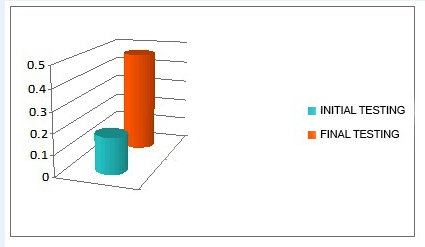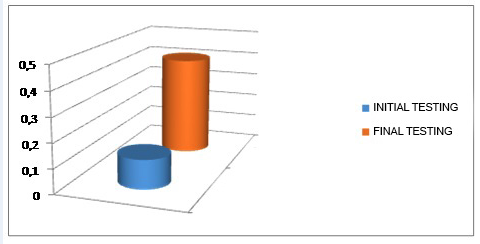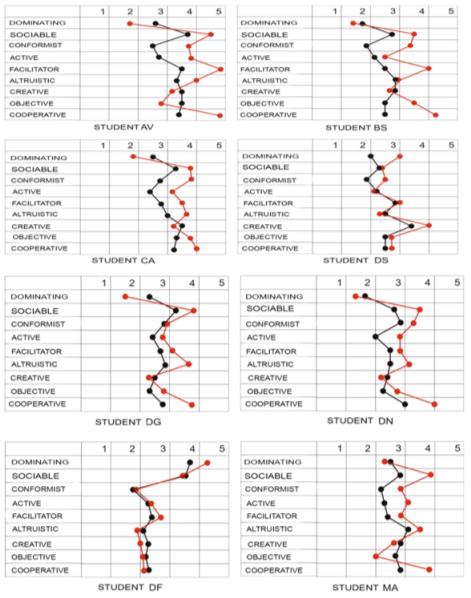Abstract
Through the objectives and functions is performing, Physical Education and Sport brings positive influence on all facets of personality: biomotor, psychomotor and socio-motor. In this regard, Physical Education and Sport is defined as "a complex system of training that simultaneously engages the individual, favouring the improvement of the physical, psychological and socio-cultural skills" (
Keywords: Educationpersonalitydidactic strategysocial integration
Introduction
Through the objectives and functions is performing, Physical Education and Sport brings positive
influence on all facets of personality: biomotor, psychomotor and socio-motor. In this regard, Physical
Education and Sport is defined as "a complex system of training that simultaneously engages the
individual, favouring the improvement of the physical, psychological and socio-cultural skills" (Dragnea
et al., 2000).
The literature recommends that social skills are taught using specific means of Physical Education
and highlights the opportunity to develop personality traits through this discipline Şchiopu (1970 ); Orlik
(1978 ); Underwood and Williams (1991); Hellison and Georgiadis (1992 ); Stiehl (1975); Sparks (1993
); Shilds and Bredemeier (1995); Cutforth and Parker (1996).
Regarding the influence of Physical Education and Sport on improving team spirit, studies were
conducted by Zamfir (1982); Glover and Midura (1992); Hellion (1996); Feşteu (1998); Derlogea (2006);
Red (2008) etc.
Content, Methodology
Our experimental approach was focused on verifying the contribution of the formal motor
activities orientated on the personality development of the pupils from their social integration perspective.
The research approach was based on the following working hypothesis: I1 The application of educational motor games regarding speed and coordination (5th grade) and
some specific exercises regarding sports games like basketball and football (7th grade) will provide
collaboration and cooperation, will determine the intellectual level of the pupils and increase group
cohesion;
I2 Operating through educational games and speed motor skills as well as team sports exercises specific to basketball and football having cooperation and collaboration character determines the level of
the students; improves interpersonal behaviour by modifying individual psycho-social profile.
During the experimental research achieved in „Vintilă Bratianu” Gymnasium School from Stefanesti, Arges, at the 5th and 7th grade level, the independent variables were the didactic strategy, the
formal motor activities, the methods, means and the organization forms proposed by us, the dependent
variable being the behaviour the pupils in the group.
One of the experimental groups is formed from 18 pupils of 5th grade. The other group is
represented by the 28 pupils of 7th grade. The pupils from 5th grade are very familiarly with each other,
the group being the same since 1st grade. Conversely, the 7th grade was formed by the union of two 6th
former classes which, in the previously classes, they played a lot of activities in common.
In order to have the confidentiality of the data we wrote the initials of the subjects when we did the
sociometric matrix.
Our experiment is a longitudinal, provoked and natural one and it was conducted between
17.09.2014 - 29.01.2015.
By the content of the didactical strategy we wanted to develop the skills of the "Personality
features improvement" category stated in the Physical Education and Sport syllabus regarding those
classes. The methodology that was applied during the experiment was orientated in two directions: •For the 5th grade, we had in mind the fact that the pupils have the age when the best way to learn the knowledge and motor skills is still the game. On this line we had choose the motor games (23 games)
to improve two base motor skills, speed and coordination, skills that are recommended to be intensely
improved at this age (11-12 years);
•For the 7th grade, we used exercises in order to improve the motor skills specific for basketball and football knowing that the pupils are older and they have a better motor background.
Findings
The results of the experiment were analyzed in two ways: the dynamics of the social behaviour
and the members’ status from the experimental groups; the determination of the interpersonal behaviour
and the achievement of the psychosocial individual profile.
The subjects of the two groups had fill in a sociometric questionnaire at the beginning and at the
end of the experimental period that was focused on the interpersonal relationships from the class micro-
group. The results were compared in order to verify the first hypothesis according which, if the motor
activities programme with collaboration tasks has contributed to the improvement of social behaviour by
increasing the group cohesion and of the status of its members.
We also achieved a sociometric matrix that was represented by a table with double approach, each
subject being marked in the matrix based on the established code (the initials of the name and surname).
For each subject we marked the attractions that were expressed, noted with „+” and the rejections market
with „-“. The sociometric matrix expresses the central result of the number and the values of all
preferences and rejections obtained by each subject.


The 5th grade subjects had a progression from a week cohesion group to a medium, moderate
cohesion one (graphic 1). At the end of the experiment we determined the increase of the cohesion index
from 0,1, in the initial testing to 0,45, which demonstrates the improvement of the relations inside the
experimental group and by this the I1 hypothesis is confirmed (graphic 2).
The same positive evolution is observed at the 7th grade too, from a weak cohesion group (0.12)
toward a moderate cohesion group (0.41), results that confirm the I1 hypothesis, demonstrating in the same time an improvement of the group members relations'.
In what concerns the subjects ranking, at the 5th grade we found the following situation:
subject had the most popular member status, 12 subjects were accepted and 5 of them were marginalized
and accepted ones' increased and the number of the marginalized ones' decreased:
and 2 marginalized.
The ranking of the 7th grade subjects shoed the following dynamic:
popular, 14 are accepted, 2 indifferent and 10 marginalized, at the first evaluation; 5 popular subjects, 15
accepted subjects, 5 indifferent and 3 marginalized, at the end of the second evaluation.
So, we found that the positive changes in what concerns the dynamic of the cohesion index as well
as the members status from the experimental groups are determined by the didactic strategy which is
focused on games and motor exercises that are based on collaboration and cooperation, during the 28th
lessons of physical education for the 5th grade and 34 for the 7th grade.
The interpersonal behaviour determination was achieved by completing an individual answer sheet
elaborated by M. Zlate (2008, p.233). The sheet contains nine personality features, considered by Zlate as
being essentials for the individual interpersonal behaviour determination.
Each subject puts a score between 1 and 5 using the Linkert scale to each member of the group.
The sheets were completed at the beginning and at the end of the experimental period by the subjects of
the two groups.
The appreciation in value of the subject's personality was done by computing the average of the
score received from the other members of the group. Based on the obtained values the psychosocial
profile of the subjects was made (fig.1 for 5th grade).
The value interpretation of the data is emphasized by comparing the averages from the initial and
final tests and the graphic interpretation was realised depending on the left or right orientation of the
obtained data (fig.1).
Analysing the psychosocial profiles of the 18th subjects of the 5th grade, we can see that, at the
initial test, they have a main orientation to the right, which demonstrates that the formal activities
programme aimed in a positive way the for collaboration personality features: sociable; positive
interaction facilitator; unselfish, cooperating. So, the working hypothesis I2 according to which, by acting with some games of speed and coordination improvement, having a cooperation and collaboration
character, the interpersonal behaviour of the group can be improved.
For the 7th grade we compared the results of the initial and final test, as well as the psychosocial
profiles in order to verify the I2 working hypothesis. The increased values from answering sheets in final test as well as the right orientation of the psychosocial profiles demonstrates that the collaboration motor
activities program has led to an improvement of the interpersonal behaviour specific to the group,
verifying the I2.

Conclusions
One of the learning content that has been introduced for Physical Education discipline is "The
personality features improvement'". This contributes to the achievement of the key competences set called
"Interpersonal, intercultural, social and civics competences".
The new learning content has received a general competence called "The application of the rules
system that is specific to the organization and practice of the physical education and sport activities and
the adopting of an adequate behaviour in the framework of the interpersonal and group relationships",
having subordinated a set of specific competences/classes level. The learning category that aims the
improvement of the personality features of the pupils demonstrates that the actual Physical Education
doesn't have to be focused only on motor performance, acting exclusively on biomotor side, but also it
has to contribute to the entire personality improvement of the pupils.
The learning units related to "Personality features improvement" content can be activated by using
a didactic strategy that is adequate it to the educational needs of the pupils and the actual social requires,
orientated on contents, methods, means, organization forms that will facilitate cooperation, collaboration,
benevolent, team spirit, fair-play, etc.
The sociometric date recorded at the end of the experiment determines us to say that the working
hypothesis I1 is confirmed in the case of both experimental groups. The practice of the learning contents, by a didactic methodology that is adequate it to the educational needs of the pupils and the actual social needs, has led to the improvement of the cohesion between the experimental groups members', as well as to the improvement of the subject’s status inside the groups.
The individual psychosocial profiles that are emphasizing each personality feature, that were determined at the end of the experiment, give us objective arguments to appreciate that most of the subjects have made an improvement of the personality features indices that are adequate for the social integration. The increased values and the right orientation of the psychosocial profiles demonstrated that the working hypothesis I2 is confirmed for both experimental groups.
References
- Cutforth, N., and Parker, M. (1996). Promoting Affective Development in Physical Education – The value of journal writing, Journal of Physical Education, Recreation and Dance, (7), pp. 19 - 23.
- Derlogea, Ş. (2006). Team-building – 50 games and their role in team building, Amaltea Publishing House, Bucharest.
- Dragnea, A., et.al. (2000). The theory of Physical education and sport. School book Publishing House, Bucharest, p. 58;
- Feşteu, D. (1998). Social learning by physical education lessons in Romania. Doctoral thesis, Brunel University, Uk.
- Glover, D., Midura, D. (1992). Team building through physical challenges. Champaign, Illinois; Human Kinetics.
- Hellion, J. (1996). If we built it, they will come creating an emotionally safe physical education environment. Journal of Physical Education, Recreation and Dance, pp. 40 - 44.
- Hellison, D. and Georgiadis, A. (1992). Teaching values through basketball. Strategies, (5).
- Mayer, R. E., Stiehl, C. C.& Greeno, J. G. (1975). Acquisition of understanding and skill in relation to subjects' preparation and meaningfulness of instruction. Journal of Educational Psychology, 67.
- Orlick. T. (1978). The cooperative sports and games book: Challenge without competition. Pantheon Books, New York.
- Roşu, D. (2008). Animation techniques - mountain team building, Universitaria Publishing House, Craiova.
- Şchiopu, U. (1970). The psychological issues of the game and amusement, Didactic and Pedagogic Publishing House;
- Orlick,T. (1978). The cooperative sports and games book: Challenge without competition. Pantheon Books, New York.
- Underwood, M. and Williams, A. (1991). Personal and social education trough Gymnastics, British Journal of Physical Education, 22 (4).
- Sparks,W., (1993). Promoting self-responsibility and Decision Making with At-Risk Student. Journal of Physical Education, Recreation and Dance, (2), pp.75-79.
- Shilds, D.L. and Bredemeier, B.J. (1995). Character development and physical activity, Champaign IL: Human Kinetics.
- Zamfir, E. (1982). The interpersonal relationships culture, Political Publishing House, Bucharest.
- Zlate, M. (2008), Ego and Personality, Trei Publishing, Bucharest.
Copyright information

This work is licensed under a Creative Commons Attribution-NonCommercial-NoDerivatives 4.0 International License.
About this article
Publication Date
25 May 2017
Article Doi
eBook ISBN
978-1-80296-022-8
Publisher
Future Academy
Volume
23
Print ISBN (optional)
-
Edition Number
1st Edition
Pages
1-2032
Subjects
Educational strategies, educational policy, organization of education, management of education, teacher, teacher training
Cite this article as:
Mihailescu, L., & Catrina, M. (2017). The Physical Education Determinant of Children Social Integration. In E. Soare, & C. Langa (Eds.), Education Facing Contemporary World Issues, vol 23. European Proceedings of Social and Behavioural Sciences (pp. 1470-1476). Future Academy. https://doi.org/10.15405/epsbs.2017.05.02.180
